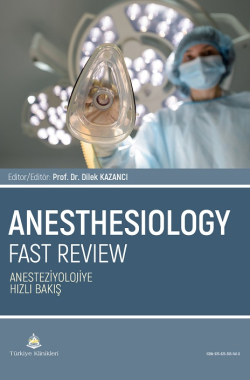NORMAL ACID BASE BALANCE
Cihangir Doğu1
Temel Kayan2
1Ankara City Hospital, Department of Anesthesiology and Reanimation, Ankara, Türkiye
2Ankara City Hospital, Department of Intensive Care, Ankara, Türkiye
Doğu C, Kayan T. Normal Acid Base Balance. In: Kazancı D, editor. Anesthesiology Fast Review. 1st ed. Ankara: Türkiye Klinikleri; 2025. p.91-97.
ABSTRACT
- A Hydrogen balance is necessary for biochemical reactions to take place.
- It arises from CO2 production and during carbohydrate, fat and protein metabolism.
- Respiratory and renal systems are of primary importance in maintaining the balance.
- An acid is a substance that gives H+ ions in water, while a base is a substance that takes H+.
- Carbonic acid/bicarbonate is the most important buffer system in blood. It regulates blood pH level due to its effect on PaCO2.
- Explaining what the primary deterioration is the first step in assessing the patient’s acid/base status. Secondary step is whether there is compensation.
- Compensation of respiratory-induced impairments is provided metabolically, while metabolic disorders are compensated by the lungs.
- There are four acid-base disorders. Respiratory asidosis, alkalosis, metabolic asidosis and alkalosis.
- A new calculation method is based on electrical neutrality of organism named as Steward’s equation.
- Electroneutrality is ensured by three variables. Strong ion difference of the plasma, PaCO2, weak acids. With this method, the effect of the liver and gastrointestinal system on the acid-base balance can be calculated.
Keywords: Acid-base imbalance; Acidosis; Respiratory insufficiency; Carbon dioxide; Blood gas analysis
×
Kaynak Göster
Referanslar
- Fencl V, Leith DE. Stewart's quantitative acid-base chemistry: Applications in biology and medicine. Respiration Physiology. 1993;91(1):1-16. [Crossref] [PubMed]
- Severinghaus JW. Acid-base balance nomogram--a Boston-Copenhagen detente. Anesthesiology. 1976;45(5):539-541. [Crossref]
- Neligan PJ. Perioperative Acid-Base Balance. In: Miller's Anesthesia. 2022:1374-1397. [Link]
- Santra G. Spectrum of Disorders associated with Tetany. The Journal of the Association of Physicians of India. 2023;71(3):11-12. [Crossref] [PubMed]
- Sanghavi S. MD TJAM and ERSM. Acid-Base Balance. In: Murray & Nadel's Textbook of Respiratory Medicine. 154-167.e3. [Link]
- Soar J, Böttiger BW, Carli P, et al. European Resuscitation Council Guidelines 2021: Adult advanced life support. Resuscitation. 2021;161:115-151. [Crossref] [PubMed]
- Williams G. Fluid, electrolyte and acid-base balance. In: Smith and Aitkenhead's Textbook of Anaesthesia. 2019:216-233. [Link]
- Story DA. Stewart Acid-Base: A Simplified Bedside Approach. Anesthesia & Analgesia. 2016;123(2):511-515. [Crossref] [PubMed]

